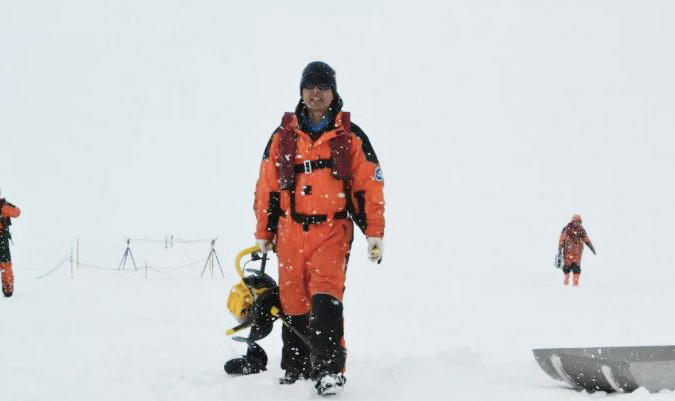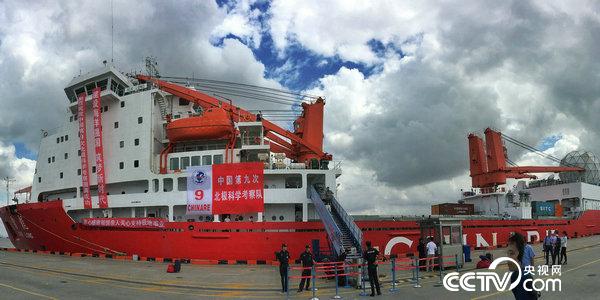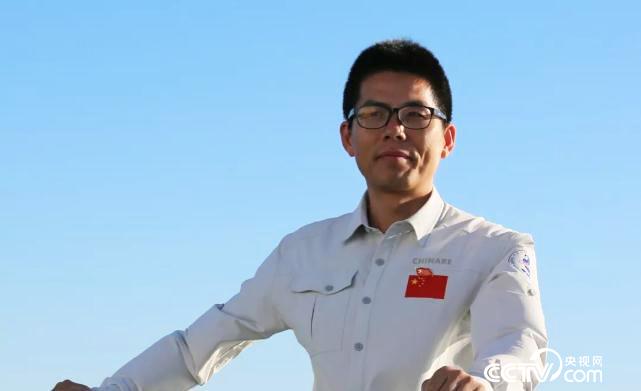Lei Ruibo, the "polar warrior": More than ten years of persistence, deciphering the sea ice code.

Lei Ruibo performs scientific research tasks in the polar regions (ChinaPhoto courtesy of Polar Research Center)
CCTV News:The icebergs in the Antarctic are majestic and magnificent, and there is a faint blue light under the white coat, which is breathtaking; The arctic ocean is frozen for thousands of miles, and the fog lock is boundless. They quietly wait for someone to cross and explore the past and future here.
It was not until 1970s and 1980s that sea ice research formed a relatively mature research system in the world, and there were less than 100 scholars engaged in sea ice physics research. In China, there are about 10 teams engaged in polar sea ice research for a long time, and Lei Ruibo, a post-80s researcher, is one of them.
As a loyal observer and researcher of polar sea ice, he has participated in the 22nd Antarctic expedition in China to carry out the wintering mission, participated in six scientific expeditions to the Arctic in China, one expedition to the Yellow River Station in the Arctic, one expedition to the ice around the Baltic Sea Lake, and served as the assistant to the chief scientist of the Arctic scientific expedition in China twice.
When he first went to the South Pole at the age of 24, Lei Ruibo never thought that this piece of ice and snow would make him devote more than ten years of research enthusiasm; At the age of 37, he served as the chief scientist assistant and captain of the ninth Arctic scientific expedition in China. He has faded from his youth 13 years ago, leaving behind the perseverance and composure of a polar expedition worker.
A coincidence, the southern guy became attached to the ice and snow.
"It is difficult for southerners to understand the snow and ice in the north, and it is difficult for northerners to understand the rain in the south." Lei Ruibo was born in a rural family in Qingyuan, Guangdong Province. He was admitted to Hohai University as an undergraduate in 2000 and entered Dalian University of Technology as a postgraduate in 2004. From the southern end of the motherland to the north, let this southern boy know what is called climate difference for the first time.
By chance when he was in graduate school in 2005, he was fortunate to be the first member of Dalian University of Technology to participate in the Chinese Antarctic expedition to carry out the wintering mission and undertake the sea ice observation mission. The trip to the Antarctic made him attached to the ice and snow, and the first turning point appeared in his life direction.
"Observing in Antarctica is a hard and lonely job, and it often depends on self-study," Lei Ruibo said. Before going to Antarctica, Professor Li Zhijun carefully guided the preparation of on-site implementation plan and taught observation experience. However, the on-site situation is changing rapidly, which requires constant exploration and practice. Due to long-term field exposure, the orange-red winter clothes he wore obviously faded and the burrs were thrown up.
At the beginning of 2007, Lei Ruibo returned to China after completing the wintering sea ice observation mission, and at the same time brought back the complete ice cycle observation data he obtained in the East Pole, which was also the first quantitative and continuous sea ice observation data obtained by China in this area.

Lei Ruibo with the teamReturning from China’s 22nd Antarctic expedition (Source: vision china)
In 2009, Lei Ruibo entered the postdoctoral workstation in polar research institute of china and engaged in sea ice research. He joined polar research institute of china in 2012 and officially became a "professional player" in polar sea ice research.
Stick to the vast and mysterious polar regions,bench to sit ten years cold
Polar region is a mysterious and little known region, and there is no ready-made cognition for reference. As a polar researcher, only by sticking to the scene can we have the opportunity to decipher this complex mechanism of change.
By combining the observation data of the ice bottom position under the ice and the snow thickness on the ice surface, researchers can accurately measure the change of ice thickness of sea ice, thus understanding the impact of global warming on sea ice. Because the ice thickness can not be accurately measured by satellite remote sensing and other means, the ice thickness has become the key to solve the climate system change.
"The bitterness of wintering is unforgettable." Lei Ruibo recalled. Injured in the wild, almost lost two fingers; It is difficult for a husband and a son to get together with their families and leave them more. Do you want to stick to it? For a long time, Lei Ruibo wavered. At the beginning of 2008, after missing two opportunities to reunite with his family during the Spring Festival, he finally got the opportunity to return to Guangdong for the Spring Festival from Dalian. Unexpectedly, rare rain, snow and freezing weather occurred that year, and traffic and power transmission were interrupted … … Seeing the plight of passengers tossing and turning all the way, Lei Ruibo secretly made up his mind to devote himself to sea ice research and fight disasters.
In 2008, after taking part in China’s third scientific expedition to the Arctic, the expedition members changed from batch to batch, and Lei Ruibo never left the Arctic. After six scientific expeditions to the Arctic, the data quality obtained by Lei Ruibo and the team has been greatly improved, and some of them are even ahead of the international level.
"The bench will be cold for ten years, and the article will not be empty." Using the polar observation data accumulated for many years and the advanced ocean numerical model, Lei Ruibo focused on scientific issues such as the mechanism of rapid reduction of Arctic sea ice and its impact on the weather change process in China, the impact of the reduction of Arctic sea ice on the export of fresh water from the Arctic Ocean to the Atlantic Ocean, and the impact of the latter on the ocean circulation. The results were published in many internationally renowned journals.

On September 26th, 2018, China’s ninth Arctic expedition team successfully returned to Shanghai. (Source: vision china)
In 2018, 37-year-old Lei Ruibo served as chief scientist assistant and captain of the sea ice team of the ninth Arctic scientific expedition in China. The expedition experienced a rare storm and snow, and even experienced unexpected situations such as dense fog and ice surface rupture. At the long-term ice station of the ninth Arctic scientific expedition in China, when both the A and B prototypes of the unattended observation system announced the success of data reception, the implicit Lei Ruibo shook hands and hugged his teammates one by one.
Academic service to the country, filling the gap in polar research
"Academics can also serve the country." Engaged in polar sea ice observation and research for ten years, Lei Ruibo has made outstanding achievements in the research and development and application of sea ice observation technology, the thermal and dynamic mechanism of sea ice and the long-term change mechanism of Arctic sea ice, and has gained a certain reputation among international peers.

Lei Ruibo data map (ChinaPhoto courtesy of Polar Research Center)
"Polar investigation is highly dependent on the scientific and technological support platform. There are many gaps in the field of polar research, waiting to be filled." Just as Lei Ruibo asked himself, he grasped the international research trends, combined with national needs, and sprinted to the international level.
At present, the biggest difficulty in polar sea ice observation and research in China is that there is no ready-made equipment available and it depends on foreign countries. Lei Ruibo led the team to cooperate with foreign universities and research institutes, introduce digestion, absorption and innovation, and overcome the core investigation equipment blocked by technology; They cooperated with five scientific research institutions, including Taiyuan University of Technology, and developed the manned sea ice observation and technology completely from foreign countries to the independent research and development of unattended observation equipment and the successful application of domestic integrated automatic observation equipment. More importantly, the data obtained by these key devices can support some research directions to achieve breakthrough results.
Lei Ruibo attaches great importance to the research and development of observation technology, and cooperates with Taiyuan University of Technology to develop temperature chain buoys and material balance buoys, which are widely used in China’s Arctic exploration. As the chief engineer of the national key research and development project "unattended sea ice observation system", he led the team to tackle key technical problems, successfully developed two sets of prototypes and successfully applied them. The system plans to participate in the international MOSAiC inspection plan next year, which will greatly enhance China’s international reputation in this field.
Scientific research institutes and universities are the main bodies of scientific and technological innovation, and only by cooperating can they exert their greatest strength. Lei Ruibo’s team, together with the National Marine Environmental Forecasting Center and other cooperative units, carried out scientific investigation and research on sea-air-ice in the Arctic, which gained valuable data and experience for China to carry out scientific research in the Arctic and made positive contributions to enhancing China’s polar discourse power.
Look at the most beautiful and boundless scenery and experience the most difficult loneliness. On the road of polar scientific research, it is not only his love for the polar region, but also the five-star red flag flying in the snow that supports Lei Ruibo to stick to the square of sea ice research.
"Although science has no national boundaries, scientists have their own motherland." Lei Ruibo said that the achievements made in the field of polar scientific research are like athletes winning prizes in international competitions. At that moment, the athlete represented the motherland, and he closely linked his destiny with the motherland. (Text/Lu Tao, Liu Kefeng)